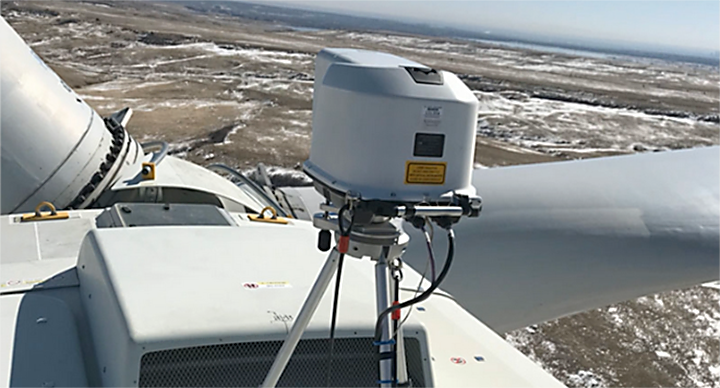Leosphere, a Vaisala company that specializes in developing, manufacturing, and servicing turnkey wind Lidar instruments for wind energy, recently announced, in collaboration with DNV, that its WindCube® Nacelle is the first Lidar to receive full classification according to the new IEC 61400-50-3 standard for nacelle-based Lidar. Wind Systems recently discussed this achievement with Matthieu Boquet, the company’s head of Market and Offering, Renewable Energy.
What is the WindCube Nacelle and what can it do for the wind industry?
WindCube Nacelle is a laser-based, remote-sensing device that can be easily installed on top of a wind turbine. It measures the incoming wind to deliver an accurate understanding of the performance of the wind turbine, making it possible to verify that it performs properly and delivers the power that is expected. It is quite easy to deploy on a wind turbine where it continuously measures the wind in front to measure the power curve of the wind turbine. This is a very important parameter as it indicates the efficiency of a wind turbine. The accuracy of this measurement is essential in understanding if there is any under-performance. If the measured power curve is lower than the expected power curve, then you would have to take some corrective actions. And if it’s correct, then you know that your wind turbine is delivering what is expected and you are on track to meet your goals.

How does the WindCube Nacelle differ from other Lidar systems?
WindCube Nacelle is now approved as a standard instrument for power performance testing (PPT). PPT is the action of measuring the power curve of a wind turbine. The WindCube Nacelle is the first of its kind to be approved by the highest industry standard that exists — the IEC standard — and is a classified instrument to perform state-of-the-art power performance testing. WindCube Nacelle has a proven track record as it has been used for years by many turbine manufacturers and wind-farm developers and operators. It is already included in many developer and manufacturer turbine supply agreements.
Many of our customers say it is the most accurate instrument and the easiest to use and deploy. It has several mounting options, so it’s very versatile and can be installed on any type of wind turbine.
The WindCube Nacelle is the most trusted on the market thanks to its long track record and now bolstered by this IEC classification. And, in the wind industry, trust in wind data is critical. Our WindCube Nacelle has been installed on more than 500 wind turbines, and it has really helped to secure its proven performance and ease-of-use.
How did Leosphere’s collaboration with DNV come about?
We have collaborated on Lidars with DNV for many years — not only the WindCube Nacelle but with our entire suite of Lidar devices, designed for all stages of a wind-farm project whether onshore or offshore. Our collaboration with DNV is fundamental for industry adoption of Lidars and defines the best practices for using Lidars. The classification that we have performed with DNV was just a natural next step thanks to all the projects that we have performed with them so far.
DNV works regularly with all of our Lidars, including WindCube Nacelle, for the calibration of the devices. This is something that they do all year round, as Lidars have to be calibrated for specific measurement campaigns. This is not the case for every campaign but in the case of warranty power curve verification, the device has to be verified by a third party. We have been collaborating on that with DNV and other trusted third party experts.
What are the advantages for the WindCube Nacelle receiving that full classification according to the new IEC 61400-50-3 standard?
With the IEC classification, the WindCube Nacelle is officially an industry-accepted instrument for PPT. Before that, only met masts were accepted by the IEC Standards for verifying the performance of a wind turbine. Met masts are not easy to deploy, are expensive, and cannot be repurposed for new campaigns. For power performance testing, you only need the instrumentation for three to six months. Deploying, installing, and erecting a met mast just for conducting PPT is not efficient or cost effective. Now, with the new IEC standard and the WindCube Nacelle classification, you have a really efficient alternative solution to verify wind turbines and maximize wind-farm energy production.
Why is it important to have accurate and reliable power performance testing?
It’s important to have accurate PPT, but it’s also important first to make PPT. Because of the difficulty and the cost of using a met mast, only a few wind turbines can be tested and mostly only during the commissioning phase of the wind farm — not during the 20 or 25 years of operation. With so few tests, you cannot be sure that your wind farm is delivering at the right level of performance, nor have the diagnostics to take corrective actions and improve your energy production. It’s important to have this kind of solution to optimize performance and maximize your profits. Then, of course, the measurement solution has to be accurate; the more accurate the data is, the better the analysis.
What new enhancements does the WindCube Nacelle include, and how will they provide richer data options while making the system easier to use?
In addition to the IEC Classification that we just obtained, we also introduced a set of new mounting options to facilitate the installation of the Lidar on a variety of wind-turbine nacelles, and there is a large variety of wind-turbine nacelles out there. The WindCube Nacelle now also supports an integrated Vaisala PTH weather sensor, which measures pressure, temperature, and humidity. This additional data augments PPT data, providing valuable insights into overall wind-turbine performance. The WindCube Nacelle is now also compatible with our web-based fleet-monitoring solution, making remote system configuration, monitoring, and data access easy, whether you have a single Lidar or a fleet.
The Lidar can now measure the rotor equivalent wind speed (REWS), which is an additional output from the Lidar. It comes in addition to the already existing hub height wind speed, which is, in most of the cases, used for power performance testing, but we are also providing this alternative value in order to better understand the behavior of turbines with large rotors.
Finally, it is completed by WindCube Insights Analytics software that enables a very quick calculation of the power curve of the wind turbine, following the new IEC standard, so it’s a very simple process to analyze the data coming from the WindCube Nacelle for measuring the power curve.
How will the WindCube Nacelle’s advanced enhancements further establish Leosphere and Vaisala as the go-to source to empower wind-industry players?
There’s continuous improvement in our industry to further reduce the cost of wind energy. We’re glad that we can contribute to this by delivering modern wind-measurement solutions that provide accurate data while improving safety for wind-farm employees. We’re also happy to support the standardization of new, better practices to improve wind-industry sustainability, and we expect that more PPT will be performed following an accurate and cost-efficient process as this is fundamental to optimize the performance of wind farms and the cost of renewable energy.
More info www.windcubelidar.com




























